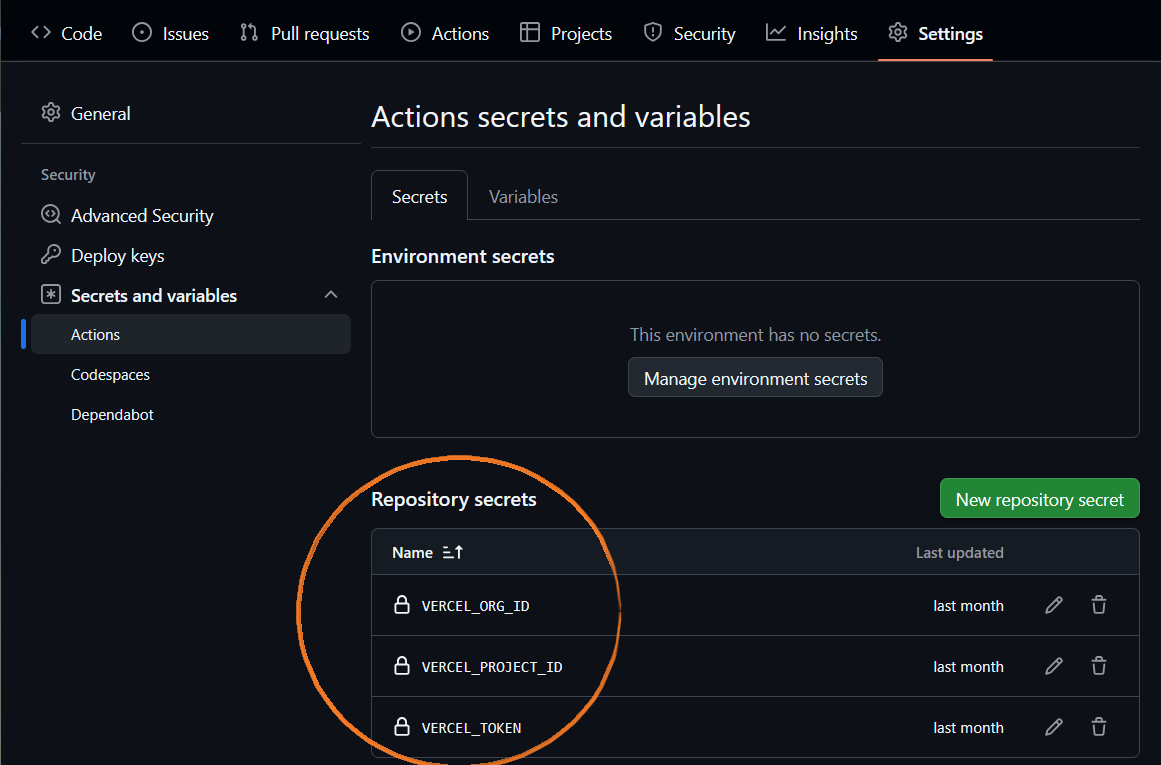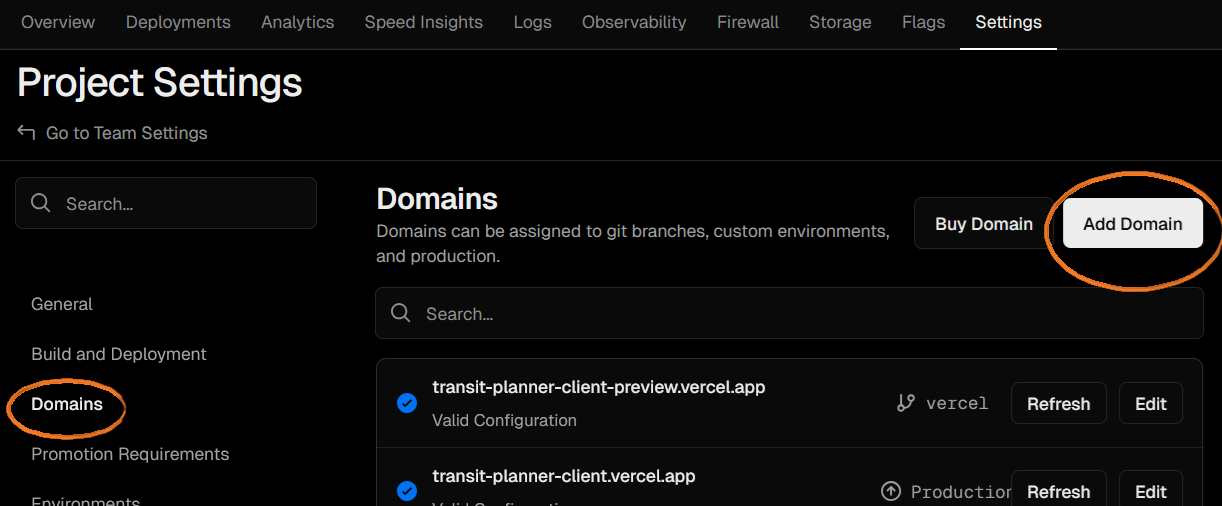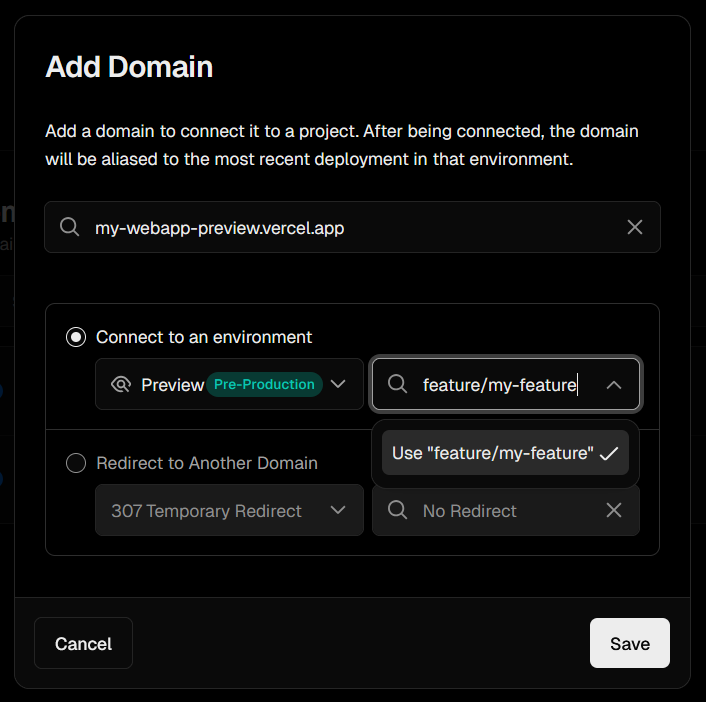Free Fixed URL to your latest Vercel preview with GitHub Actions
On small scale projects hosted on Vercel, it can be useful to have a fixed URL that always points to the latest preview
deployment. One can easily achieve this - at no cost! - using GitHub Actions’ repository_dispatch events emitted by
Vercel, as well as the Vercel CLI, to create a free Vercel custom domain upon successful deployment to your Preview
environment.

The transit-planner-client-preview.vercel.app domain was automatically created when this build was deployed to my
Preview environment
Despite constantly checking how my webapps look on mobile using my browser’s dev tools, I regularly got a few surprises once checking the final deployed result on an actual device.
While Vercel kindly exposes various URLs to access a preview deployment, these URLs, despite following a predictable pattern, change with every deployment - making them unusable in some situations, such as applications with a callback-based third-party authentication layer.

Ah yes silly me, I completely forgot to whitelist my-web-application-git-fe-dfe98e7-corentindautremes-projects.vercel.app as a valid redirection URI, how could I be so forgetful
Now if you could always access your latest Vercel preview deployment with a fixed, never-changing URL, like my-web-application-preview.vercel.app, you could add this URL to the redirection whitelist of your OAuth provider. Lucky you, that’s exactly what we’re going to set up today.
Vercel custom domains (aka aliases)
Vercel allows you to create custom domains that target a specific deployment, by attaching the domain to an environment, and a branch (if the selected environment is Preview). That means that you could, after each new deployment of a branch to your Preview environment, log in to Vercel and manually create and attach a custom domain to your Preview environment and deployed branch. Yawn.
If you have a feeling there’s a better way to do this than manually, you would be right: Vercel has a CLI tool
that includes a vercel alias command. Interestingly, this command doesn’t seem to
make
a difference between Preview and Production environment aliases and doesn’t require you to specify a branch - so not
only can you automate this process, going
through the CLI is actually easier. Pinch
me.
vercel alias set [deployment-url] [custom-domain]
One last and very valuable information is that, while the Vercel docs heavily insist on the fact that you can use
your own domain as a custom alias (they even offer to purchase one through them - how convenient!), you can instead
create a
.vercel.app domain for free. While this is vaguely mentioned in the docs, I would argue this isn’t super
clear.
Vercel repository_dispatch events
Additionally, Vercel’s GitHub integration docs include a Repository dispatch events section that states the following:
Vercel sends
repository_dispatchevents to GitHub when the status of your deployment changes. These events can trigger GitHub Actions […].
That sounds nice. Now, could there be an event sent when a deployment to the Preview environment ends successfully, upon
which we could, say, call the Vercel CLI to create an alias? According to Vercel’s own list of
repository_dispatch events, yes:
# Deployment has finished building and has automatically been promoted to production
- 'vercel.deployment.success'
I’ll just point out that this description isn’t quite accurate - the vercel.deployment.success event is emitted
upon
successful deployment to any environment, regardless of whether this deployment has been promoted to Production or not.
Vercel’s events are published with an accompanying payload that looks like this:
{
"environment": "production",
"git": {
"ref": "main",
"sha": "abcdef1234567890abcdef1234567890abcdef12",
"shortSha": "abcdef1"
},
"id": "dpl_1234567890abcdefghijklmnopqrstuvwxyz",
"project": {
"id": "prj_abcdef1234567890abcdef1234567890",
"name": "example-project"
},
"state": {
"type": "pending"
},
"url": "https://example-project-abc123.vercel.app"
}
2 fields are particularly interesting to us:
environment- we’re interested in deployments to thepreviewenvironment, so we’ll have to pay attention to this valueurl- this field will be populated with the preview deployment’s URL, which we will need to create an alias via the Vercel CLI
So, we can trigger a GitHub Actions workflow when a deployment terminates successfully, and we can use the Vercel CLI to
create a free .vercel.app alias (aka custom domain) for the environment on which the deployment was made. Let’s get
cracking.
Update an alias on successful deployment to Preview
The following GitHub Actions workflow, once pushed to your default branch, will listen for vercel.deoloyment.success
events and, if such an event was emitted for a deployment to the Preview environment, will recreate alias
{your-alias} (which you will need to replace with your own alias - ideally one ending in .vercel.app, for reason$
mentioned earlier) for the
Preview deployment URL that Vercel generated.
name: Create Alias For Vercel Preview Deployment
env:
VERCEL_ORG_ID: ${{ secrets.VERCEL_ORG_ID }}
VERCEL_PROJECT_ID: ${{ secrets.VERCEL_PROJECT_ID }}
on:
repository_dispatch:
types:
- 'vercel.deployment.success'
jobs:
create-alias:
if: github.event.client_payload.environment == 'preview'
runs-on: ubuntu-latest
steps:
- name: Install Node.js
uses: actions/setup-node@v3
with:
node-version: 18
- uses: pnpm/action-setup@v2
name: Install pnpm
id: pnpm-install
with:
version: 7
run_install: false
- name: Install Vercel CLI
run: pnpm add --global vercel@latest
- name: Create Alias
env:
DEPLOYED_URL: ${{ github.event.client_payload.url }}
run: |
vercel alias rm {your-alias} --yes --token=${{ secrets.VERCEL_TOKEN }}
vercel alias set $DEPLOYED_URL {your-alias} --token=${{ secrets.VERCEL_TOKEN }}
If you wish to use this workflow as-is, you’ll need to do 3 things:
1. Define the following 3 actions secrets on your GitHub project (Settings > Security > Secrets and variables > Actions > Repository Secrets):
VERCEL_ORG_ID: known as Team ID these days on Vercel; can be found in your Vercel team’s settings (by default your team is called{your-vercel-username}s-projects), under General > Team IDVERCEL_PROJECT_ID: can be found in your Vercel project’s settings, under General > Project IDVERCEL_TOKEN: a Vercel personal token; if you don’t already have one, you can generate one from the Vercel dashboard by clicking on your user icon in the top right > Account Settings > Tokens

2. Replace {your-alias} with the URL you wish to use
- For example,
my-webapp-preview.vercel.app(remember that an alias in.vercel.appcan be used for free, as long as no one has claimed it first)
...
- name: Create Alias
env:
DEPLOYED_URL: ${{ github.event.client_payload.url }}
run: |
- vercel alias rm {your-alias} --yes --token=${{ secrets.VERCEL_TOKEN }}
+ vercel alias rm my-webapp-preview.vercel.app --yes --token=${{ secrets.VERCEL_TOKEN }}
- vercel alias set $DEPLOYED_URL {your-alias} --token=${{ secrets.VERCEL_TOKEN }}
+ vercel alias set $DEPLOYED_URL my-webapp-preview.vercel.app --token=${{ secrets.VERCEL_TOKEN }}
3. manually create the alias that you chose in the previous step, either via the Vercel CLI or on the Vercel dashboard directly
- This is because I was lazy and didn’t implement a check that the alias exists before running
vercel alias rm - This command fails with a non-zero return code if the alias doesn’t exist - so this workflow will keep failing
until the alias is created
- If you’re feeling devopsy today, you can have a look at the
aliascommand docs to see how to implement that check yourself!
- If you’re feeling devopsy today, you can have a look at the
To manually create an alias, you can:
- Via the Vercel CLI:
- Find any valid Vercel URL for your webapp (any deployment, past or current, Preview or Production, will do)
- Run the command
vercel alias set {any-deployment-url} {your-alias}. For example:
vercel alias set my-web-application-git-fe-dfe98e7-corentindautremes-projects.vercel.app my-web-application-preview.vercel.app
- On the Vercel dashboard:
- In your project’s Settings, go to Domains
- Click on the “Add Domain” button
- Enter your alias and choose an environment (and a branch if you chose the Preview environment; stick to Production if you don’t have any active branch at the moment, you’ll override this alias next time you push a branch so it doesn’t really matter)


That’s it! Push a new branch eligible to Preview deployments, and check the Actions tab of your GitHub repository towards the end of the Vercel deployment to verify that your workflow has properly run. If it has, the webapp built from your branch should be accessible at your chosen alias, and said alias should be listed under the Domains of your deployment on Vercel.
